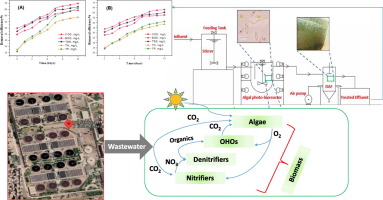Consultant expert, Dr. Mohamed Taha 1 Advanced wastewater treatment for algal removal: literature review and general thesis introduction
Consultant expert, Dr. Mohamed Taha
1 Advanced wastewater treatment for algal removal:
literature review and general thesis introduction
1.1 Background
The importance of water as a global resource for human life is irrefutable. It follows
then that the need to manage and protect this resource has been recognised for centuries,
such that it is now a conservation priority the world over. Advancements in the
efficiency, convenience and sanitation of human society have owed directly to the
development and distribution of large-scale dependable supplies of high-quality potable
water (Oswald, 1988b). Unfortunately, these same developments have also allowed for
the convenient aqueous disposal of objectionable, infectious and toxic wastes away from
their points of origin and, most commonly, into the nearest natural body of water
(Oswald, 1988b; Shiny et al., 2005). It is this aqueous waste, or ‘wastewater’, and the
processes involved with its remediation that form the basis of this thesis.
A prominent threat to global water quality in general is its contamination with human-
derived wastes of residential, industrial and commercial origins. This is particularly the
case for freshwater resources, where human-derived wastewaters are one of the major
sources of contamination and pollution (Craggs et al., 1996). In recent times, a general
decline in environmental water quality—a consequence of anthropogenic interactions—
has given rise to significant environmental problems and public health concerns
(Hoffmann, 1998). These pollution-associated issues have, therefore, justifiably received
increasing levels of attention, to the extent that they are nowadays of major concern to
modern society (de la Noüe et al., 1992).
Previously, occasional monitoring of final effluent quality from wastewater treatment
operations was often all that was required (Hurse and Connor, 2000). More recently, the
application and enforcement of environmental laws governing wastewater and its
discharge has become increasingly more stringent (Hurse and Connor, 2000) due to
heightened public pressure as well as inputs from concerned governing bodies and
agencies (Middlebrooks et al., 1974; de la Noüe et al., 1992). This increased regulatory
2
pressure has served as the historical driving force behind initial changes to wastewater
treatment technologies and indeed general waste treatment philosophy (Middlebrooks et
al., 1974) and will no doubt continue to drive process and technological advancements
into the future, or as long as the pollution-associated problems remain.
Methods for wastewater treatment used earlier last century simply relied on the self-
purification mechanisms of natural waterways for the renovation, dispersion and
redistribution of low-concentration wastes (Craggs et al., 1996). Whilst these natural
mechanisms might have historically provided adequate treatment, current effluent
discharge volumes and concentrations now exceed effective treatment thresholds of
these natural ecosystems (Harlin and Darley, 1988). This is highlighted in the fact that
many conventional treatment plants discharge in excess of 10 6 L of wastewater per day,
with nutrient levels in this discharged effluent being up to three orders of magnitude
more concentrated than in the receiving waters (de la Noüe et al., 1992; Hoffmann,
1998). It is not surprising then that municipal wastewater is recognised as one of the
main contributors to freshwater pollution and the subsequent eutrophication of receiving
water bodies (Craggs et al., 1996). Among other things, this pollution-induced
heightened eutrophic state can lead to a reduction in the natural species diversity of the
receiving waterway—destroying the ecosystem’s natural heterogeneity and subsequently
decreasing its self-purification capacity (Brix and Schierup, 1989). Without proper
attenuation of wastewater-borne bioavailable substrates prior to discharge, this ‘positive-
feedback’ cycle could result in the eventual destruction of the very aquatic ecosystems
so heavily relied upon for safe disposal.
Current global industries surrounding wastewater and its treatment technologies are both
extensive and wide-spread. Not only do these treatment options vary extensively in
terms of process and technical design, but also with respect to the associated costs and
level of operator expertise necessary for efficient operation. One of the most basic and
pioneering wastewater treatment techniques that is now recognised as being a ‘staple’
treatment alternative is the Waste Stabilisation Pond (WSP). WSPs (sometimes also
referred to as oxidation ponds, redox ponds or sewage lagoons) in their simplest form
are defined as shallow earthen basins containing wastewater of some description
(Metcalf and Eddy, 1991). Historically, WSPs are said to have been employed,
3
particularly in Asia, for the treatment of wastewater for thousands of years (Uhlmann,
1980); with the first recorded construction of a modern pond system being
الخبير الاستشاري الدكتور محمد طه
1 معالجة مياه الصرف الصحي المتقدمة لإزالة الطحالب:
مراجعة الأدبيات ومقدمة الأطروحة العامة
1.1 خلفية
أهمية الماء كمورد عالمي لحياة الإنسان لا يمكن دحضها. يتبع
ثم أنه تم الاعتراف بالحاجة إلى إدارة وحماية هذا المورد لعدة قرون ،
بحيث أصبحت الآن أولوية حماية في جميع أنحاء العالم. التقدم في
الكفاءة والراحة والصرف الصحي للمجتمع البشري مدينون مباشرة إلى
تطوير وتوزيع إمدادات كبيرة يمكن الاعتماد عليها من مواد صالحة للشرب عالية الجودة
الماء (أوزوالد ، 1988 ب). لسوء الحظ ، سمحت هذه التطورات نفسها أيضًا
التخلص المائي المريح من النفايات السامة والمزعجة والمعدية بعيدًا عن
نقاط منشئها ، والأكثر شيوعًا ، إلى أقرب مسطح طبيعي مائي
(أوزوالد ، 1988 ب ؛ شايني وآخرون ، 2005). إنها هذه النفايات المائية ، أو "مياه الصرف الصحي" ، و
العمليات المتضمنة في معالجتها والتي تشكل أساس هذه الأطروحة.
من التهديدات البارزة لنوعية المياه العالمية بشكل عام تلوثها بالإنسان-
النفايات المشتقة ذات الأصول السكنية والصناعية والتجارية. هذا بشكل خاص
حالة موارد المياه العذبة ، حيث تعد مياه الصرف الصحي المشتقة من الإنسان واحدة من أهمها
مصادر التلوث والتلوث (كراجز وآخرون ، 1996). في الآونة الأخيرة ، جنرال
تدهور جودة المياه البيئية - نتيجة للتفاعلات البشرية -
أدت إلى مشاكل بيئية كبيرة ومخاوف تتعلق بالصحة العامة
(هوفمان ، 1998). وبالتالي ، تم تلقي هذه القضايا المرتبطة بالتلوث بشكل مبرر
زيادة مستويات الاهتمام ، إلى الحد الذي يجعلها في الوقت الحاضر مصدر قلق كبير ل
المجتمع الحديث (دي لا نوي وآخرون ، 1992).
في السابق ، كانت هناك مراقبة عرضية لجودة النفايات السائلة النهائية من معالجة مياه الصرف الصحي
غالبًا ما كانت العمليات هي كل ما هو مطلوب (Hurse and Connor ، 2000). في الآونة الأخيرة ،
تطبيق وإنفاذ القوانين البيئية التي تحكم مياه الصرف الصحي ومياه الصرف الصحي
أصبح التفريغ أكثر صرامة بشكل متزايد (Hurse and Connor ، 2000) بسبب
زيادة الضغط العام وكذلك المدخلات من الهيئات الرئاسية المعنية و
وكالات (Middlebrooks et al.، 1974؛ de la Noüe et al.، 1992). زاد هذا التنظيم
2
كان الضغط بمثابة القوة الدافعة التاريخية وراء التغييرات الأولية في مياه الصرف الصحي
تقنيات المعالجة وفي الواقع فلسفة معالجة النفايات العامة (Middlebrooks et
al. ، 1974) وستواصل بلا شك قيادة عمليات التقدم والتقدم التكنولوجي
في المستقبل ، أو ما دامت المشاكل المرتبطة بالتلوث قائمة.
طرق معالجة مياه الصرف الصحي المستخدمة في وقت سابق من القرن الماضي اعتمدت ببساطة على الذات
آليات تنقية المجاري المائية الطبيعية من أجل التجديد والتشتت و
إعادة توزيع النفايات منخفضة التركيز (كراجز وآخرون ، 1996). في حين أن هذه طبيعية
قد تكون الآليات قد وفرت تاريخيًا العلاج المناسب ، التدفق الحالي
تتجاوز الآن أحجام التصريف والتركيزات عتبات المعالجة الفعالة البالغة
هذه النظم البيئية الطبيعية (هارلين ودارلي ، 1988). يتم تسليط الضوء على هذا في حقيقة أن
تصريف العديد من محطات المعالجة التقليدية ما يزيد عن 10 6 لترات من مياه الصرف الصحي يوميًا ،
مع مستويات المغذيات في هذا الصرف السائلة تصل إلى ثلاثة أوامر من حيث الحجم
أكثر تركيزًا من المياه المستقبلة (de la Noüe et al. ، 1992 ؛ Hoffmann ،
1998). ليس من المستغرب إذن أن يتم التعرف على مياه الصرف الصحي البلدية كواحدة من
المساهمين الرئيسيين في تلوث المياه العذبة وإغناء المتلقي بالمغذيات اللاحقة
المسطحات المائية (كراجز وآخرون ، 1996). من بين أمور أخرى ، هذا التلوث الناجم عن
يمكن أن يؤدي ارتفاع حالة التخثث إلى انخفاض في تنوع الأنواع الطبيعية في
استقبال الممر المائي - تدمير عدم التجانس الطبيعي للنظام البيئي وبالتالي
تقليل قدرتها على التنقية الذاتية (Brix and Schierup ، 1989). بدون سليم
توهين الأسطح المتوافرة بيولوجياً التي تنقلها المياه العادمة قبل التصريف ، وهذا إيجابي-
قد تؤدي دورة الملاحظات إلى التدمير النهائي للنظم البيئية المائية
لدرجة الاعتماد عليها بشدة للتخلص الآمن.
الصناعات العالمية الحالية المحيطة بمياه الصرف الصحي وتقنيات معالجتها كلاهما
واسع النطاق وواسع الانتشار. لا يقتصر الأمر على أن خيارات العلاج هذه تختلف بشكل كبير في
شروط العملية والتصميم الفني ، ولكن أيضًا فيما يتعلق بالتكاليف المرتبطة و
مستوى خبرة المشغل اللازم للتشغيل الفعال. واحدة من أبسط و
تقنيات معالجة مياه الصرف الصحي الرائدة التي يُعرف الآن بأنها "عنصر أساسي"
العلاج البديل هو بركة تثبيت النفايات (WSP). WSPs (أحيانًا أيضًا
يشار إليها باسم أحواض الأكسدة ، أحواض الأكسدة والاختزال أو بحيرات الصرف الصحي) في أبسط أشكالها
يتم تعريفها على أنها أحواض ترابية ضحلة تحتوي على مياه الصرف الصحي لبعض الوصف
(ميتكالف وإدي ، 1991). من الناحية التاريخية ، يُقال إن WSPs قد تم توظيفها ،
3
خاصة في آسيا ، لمعالجة مياه الصرف الصحي لآلاف السنين (أولمان ،
1980) ؛ مع أول بناء مسجل لنظام بركة حديث يجري




